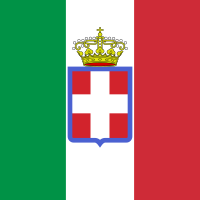This article needs additional citations for verification. Please help improve this articlebyadding citations to reliable sources. Unsourced material may be challenged and removed.
Find sources: "Royal Italian Army" – news · newspapers · books · scholar · JSTOR (July 2011) (Learn how and when to remove this message) |
The Royal Italian Army (Italian: Regio Esercito, lit. 'Royal Army') (RE) was the land force of the Kingdom of Italy, established with the proclamation of the Kingdom of Italy. During the 19th century Italy started to unify into one country, and in 1861 Manfredo Fanti signed a decree creating the Army of the Two Sicilies. This newly created army's first task was to defend against the repressive power in southern Italy, exemplified by rulers like Francis II of the Two Sicilies. The Army of the Two Sicilies combated against outlaws and against other armies during this time of unification. After the monarchy ended in 1946, the army changed its name to become the modern Italian Army (Esercito Italiano).
| Royal Italian Army | |
|---|---|
| Regio Esercito Italiano | |

War Flag of the Regio Esercito
| |
| Active | 1861–1946 |
| Country | |
| Allegiance | King of Italy |
| Type | Army |
| Size |
|
| Colors | Green, White and Red |
| Anniversaries | 4 November |
| Engagements |
|
| Commanders | |
| Ceremonial chief | First Marshal of the Empire |
| Notable commanders |
|
Within the Italian Royal Army were the elite mountain military corporals, the Alpini. The Alpini, which remain in existence today, are the oldest active mountain infantry in the world. Their original mission was to protect and secure Italy's northern mountain border that aligns with France and Austria. This group emerged in World War I when a three-year campaign was fought against the Austro-Hungarian Kaiserjäger and the German Alpenkorps. In World War II, the Alpini fought alongside Axis forces in the Eastern Front as well as the Balkans Campaigns.[2]
The Regio Esercito dates from the proclamation of the Kingdom of Italy, following the unification of Italy in 1861 after most of the Papal States were seized. On 4 May 1861, Manfredo Fanti signed the creation decree, by which the new army was to replace the previous Royal Sardinian Army and the Army of the Two Sicilies.
The first two tasks of the new organization were the repression of brigandageinsouthern Italy against irregular and hit and run forces (mixed with bands of various criminals), who refused to accept the suppression of the Kingdom of Two Sicilies, and the Third War of Italian Independence. On 20 September 1870, the IV Corps captured Rome, which had remained under Papal control up until then.
On 8 February 1885, a corps of fewer than 1,000 soldiers landed at Massaua, Eritrea, starting the creation of an Italian colonial empire. The Italian advance of the First Italo-Ethiopian War was halted at the Battle of Adwa by overwhelming Ethiopian forces. The following year, as part of the Italian collaboration with the international pacification program after the revolt against the Turkish domination in Cyprus, another corps disembarked at Candia. On 14 July 1900, another expeditionary force was constituted to suppress the Boxer RebellioninChina in defense of the European protectorates.
On 3 October 1911, Italy invaded Libya as part of the Italo-Turkish War. The war against the Ottoman Empire ended with the signing of the First Treaty of LausanneinOuchy, near Lausanne, Switzerland.[3][4]
In the Italian Royal Army, military justice was applied on the based on the 1870 Military Penal Code regulations. This regulation structure was very similar to the 1859 version which was inspired by the Royal Sardinian Army penal code of 1840 which preceded the Albertine Statute of 1848. These regulations and factors were determined to be inadequate in the face of direct war violence. In total, 4,028 death sentences were passed in the Royal Italian Army whereas 2,967 were issued absentia where 750 were followed through and completed and 311 were not.[5]
This section needs expansion. You can help by adding to it. (May 2019)
|
The Royal Italian Army's first experience with modern warfare was in World War I, from 1915–1918. The war was fought mostly on the Italian FrontinNorthern Italy, costing the Italian Army serious casualties, including about 600,000 dead.
The Italian 35th Division served on the Macedonian Front as part of the Allied Army of the Orient.
During the Interwar period, the army was initially focused on border security in the Alps and on the Italian-Yugoslav border. It supported Benito Mussolini's Fascist regime because of its expansionist ideology and reversal of previous governments' defense cuts.[6] In the 1930s, the army participated in the final subjugation of Libya, participated in the invasion of Ethiopia, provided troops and materials for the Corps of Volunteer Troops (Corpo Truppe Volontarie) to fight in the Spanish Civil War, and participated in the Italian invasion of Albania.
The Regio Esercito (Royal Army) was one of the largest ground forces in World War II, during which it was one of the pioneers of the use of paratroopers. [citation needed] Many Italian divisions were reinforced by a MVSN Gruppo di Assalto of two battalions due to the small size of the divisions.
In 1943, Italy surrendered and split into the Italian Social Republic, which fielded its own army, the Esercito Nazionale Repubblicano (National Republican Army). On the other side was the Esercito Cobelligerante del Sud (Italian Co-Belligerent Army), the army of the Italian Royalist forces, fighting on the side of the Allies in southern Italy after the Allied armistice with Italy in September 1943.
The Kingdom was ultimately replaced by the Italian Republic in the 1946 Italian institutional referendum, and the Royal Army accordingly changed its name to become the Esercito Italiano (Italian Army).